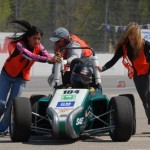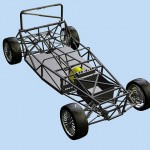Motorsports education is at its finest when it’s being applied, and NASCAR Kinetics just launched its annual Marketing In Motion competition to offer students at select universities, not just racing schools, the opportunity to take part in the fall semester motorsports education program. The winner(s) will earn an all-expense paid trip to Charlotte for the NASCAR All-Star race weekend. Take a look at this great motorsports engineering opportunity – information from NASCAR’s website – that you can apply to take part in if you attend one of the 18 eligible universities:

NASCAR Kinetics: Marketing in Motion is an innovative, engaging program that gives college students an opportunity to work through real-world business challenges and opportunities they may encounter once they begin their career. Just the like the sport itself, the NASCAR Kinetics program is fast-paced, competitive, and fun.
Whether the NASCAR Kinetics program is the first step in an illustrious career in sports or simply valuable experience for any number of paths, it will definitely leave a lasting impression on all students who participate.
What should students expect?
Expect to be challenged. To be engaged. To get out of your comfort zone and think differently. Most of all, expect to learn and have fun.
• Each team of select students will be given case studies that affect NASCAR, our sponsors, or the tracks and will be asked to create original solutions for each case study.
• Every team will also be tasked with hosting a viewing party for one pre-determined NASCAR-sanctioned race.
• A dedicated member of the NASCAR marketing department will be assigned to assist and mentor each team.
What do we expect of students?
Each student chosen for the NASCAR Kinetics program will be considered an official NASCAR brand ambassador at their school, giving them many important responsibilities.
(1) Foster brand awareness of NASCAR throughout the campus community
(2) Keep up on and report upcoming trends on your campus
(3) Create effective group dialogue within your team to solve case studies and prepare for the viewing party
(4) Communicate with your NASCAR Kinetics contact about relevant issues facing your team
(5) Utilize all your resources, including field research, professional contacts, and teammates to solve case studies
(6) Complete and submit all materials for each case study and the viewing party in the time given.
(7) Ensure all ideas are approved by NASCAR before activating
(8) Represent the NASCAR brand in a professional and positive manner
What will students get out of the NASCAR Kinetics program?
Of course, the biggest incentive to participate in the unique program is receiving relevant, hands-on experience in the world of sports. But that’s not all dedicated, ambitious students can obtain through this program:
• The team with the strongest performance (based on pre-determined guidelines) will receive an all-expense paid, once-in-a-lifetime NASCAR-sanctioned race weekend experience.
• Each student who meets the standards of work in the program will be eligible to receive a personalized letter of recommendation from NASCAR. This letter will be a powerful tool in your post-graduation plans.
• By virtue of being a NASCAR Kinetics Brand Ambassador, each student will have the opportunity to apply for various NASCAR internships and positions.
NASCAR Kinetics: Marketing in Motion is currently available at these participating universities:
Belmont Abbey College
Central Michigan University
Centenary College
Coastal Carolina University
Delaware State University
East Tennessee State University
Elon University
High Point University
Howard University
Indiana State University
Ohio State University
Ohio University
Oklahoma State University
Southern New Hampshire University
Syracuse University
Troy University
University of Central Florida
University of Florida
University of Massachusetts, Amherst
University of Miami
University of Oregon
Virginia State University
Note: When you apply for this job online, you will be required to answer the following questions:
1. Yes/No: Are you currently enrolled as an undergraduate student at one of the participating schools? If so, what school do you attend?
2. What year are you in school?
3. What is your expected date of graduation?
4. What is your cumulative GPA?
5. What is your major and minor?
6. What is the name of the high school you attended?
7. Where is the high school located?
8. What was your cumulative GPA in high school?
9. What high school sports did you play if any?
10. What extracurricular activities were you involved in if any?
11. How did you find out about NASCAR Kinetics: Marketing in Motion?
12. Why are you interested in being a part of NASCAR Kinetics: Marketing in Motion?
13. What do you hope to gain from NASCAR Kinetics: Marketing in Motion?
14. What are your career goals and how can NASCAR Kinetics: Marketing in Motion help you achieve them?
15. What skills, experience, and interests do you have that you feel would be beneficial to the NASCAR Kinetics team?
16. What extracurricular activities (i.e. student organizations, intramural sports, and/or intercollegiate athletics) are you involved in on your campus and what is your role?
17. How many hours each week do you devote your extracurricular activities?
18. How many credit hours will you be enrolled in during the semester for which you are applying to the NASCAR Kinetics program?
19. Will you seek academic credit (i.e. internship credit, independent study) from your school if you are selected to be a part of the NASCAR Kinetics team?
20. In 250 words or less, please explain the impact you think NASCAR Kinetics: Marketing in Motion will have on your college campus.



